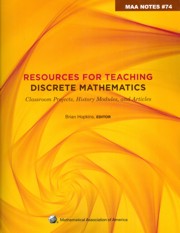Book contents
- Frontmatter
- Introduction
- Dedication
- Contents
- I Classroom-tested Projects
- II Historical Projects in Discrete Mathematics and Computer Science
- Introduction
- Binary Arithmetic: From Leibniz to von Neumann
- Arithmetic Backwards from Shannon to the Chinese Abacus
- Pascal's Treatise on the Arithmetical Triangle: Mathematical Induction, Combinations, the Binomial Theorem and Fermat's Theorem
- Early Writings on Graph Theory: Euler Circuits and The Königsberg Bridge Problem
- Counting Triangulations of a Convex Polygon
- Early Writings on Graph Theory: Hamiltonian Circuits and The Icosian Game
- Are All Infinities Created Equal?
- Early Writings on Graph Theory: Topological Connections
- A Study of Logic and Programming via Turing Machines
- Church's Thesis
- Two-Way Deterministic Finite Automata
- III Articles Extending Discrete Mathematics Content
- IV Articles on Discrete Mathematics Pedagogy
- About the Editor
Are All Infinities Created Equal?
from II - Historical Projects in Discrete Mathematics and Computer Science
- Frontmatter
- Introduction
- Dedication
- Contents
- I Classroom-tested Projects
- II Historical Projects in Discrete Mathematics and Computer Science
- Introduction
- Binary Arithmetic: From Leibniz to von Neumann
- Arithmetic Backwards from Shannon to the Chinese Abacus
- Pascal's Treatise on the Arithmetical Triangle: Mathematical Induction, Combinations, the Binomial Theorem and Fermat's Theorem
- Early Writings on Graph Theory: Euler Circuits and The Königsberg Bridge Problem
- Counting Triangulations of a Convex Polygon
- Early Writings on Graph Theory: Hamiltonian Circuits and The Icosian Game
- Are All Infinities Created Equal?
- Early Writings on Graph Theory: Topological Connections
- A Study of Logic and Programming via Turing Machines
- Church's Thesis
- Two-Way Deterministic Finite Automata
- III Articles Extending Discrete Mathematics Content
- IV Articles on Discrete Mathematics Pedagogy
- About the Editor
Summary
Georg Ferdinand Ludwig Philip Cantor (1845–1918), the founder of set theory, and considered by many as one of the most original minds in the history of mathematics, was born in St. Petersburg, Russia in 1845. His parents, who were of Jewish descent, moved the family to Frankfurt, Germany in 1856. Georg entered the Wiesbaden Gymnasium at the age of 15, and two years later began his university career at Zürich. In 1863 he moved to the University of Berlin, which during Cantor's time was considered the world's center of mathematical research. Four years later Cantor received his doctorate from the great Karl Weierstrass (1815–1897). In 1869 Cantor obtained an unpaid lecturing post, which ten years later flourished into a full professorship, at the minor University of Halle. However, he never achieved his dream of holding a Chair of Mathematics at Berlin. It is believed that one of the main reasons for this was the rejection of his theories of infinite sets by the leading mathematicians of that time, most noticeably by Leopold Kronecker (1823–1891), a professor at the University of Berlin and a very influential figure in German mathematics, both mathematically and politically.
Cantor married in 1874 and had two sons and four daughters. Ten years later Georg suffered the first of the mental breakdowns that were to plague him for the rest of his life. He died in 1918 in a mental hospital at Halle.
Information
- Type
- Chapter
- Information
- Resources for Teaching Discrete MathematicsClassroom Projects, History Modules, and Articles, pp. 225 - 230Publisher: Mathematical Association of AmericaPrint publication year: 2009
